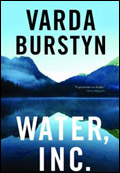My rubber boots are ankle deep in mud. An overhang of moss supported by a wedge of ice taller than I am — ice that has likely never before been exposed — is dripping water onto my hat. It is August 2004, and I am standing on the North Slope of Alaska, at a spot where warming temperatures and water flow have caused the permafrost to buckle.

Gleaning the cube.
I went there to see the changing landscape up close, and to spend time with scientists documenting those changes. Until I tromped across the tundra, I had no concrete sense of how much a part of earth’s architecture ice is — or what a sensitive barometer of the earth’s ecology the Arctic is. I have been thinking about that moment ever since, so I read Mariana Gosnell’s engaging new book Ice: The Nature, the History, and the Uses of an Astonishing Substance with relish.
“It started with an ice cube” and a trip to the Arctic, recalls the former Newsweek journalist, explaining her fascination with the subject. Gracefully written, liberally sprinkled with snippets from literature, and filled with serious scientific information, Ice explores nearly every crystalline facet imaginable. While the prospect of its 500 pages might loom chilly and bleak, Gosnell’s enthusiasm keeps the pace surprisingly lively.

Ice: The Nature, the History,
and the Uses of an Astonishing
Substance by Mariana
Gosnell, Alfred A. Knopf,
576 pgs., 2005.
Ice is a wide-ranging book, covering the geometry and physics of its subject, as well as its role in history, sports, art, refrigeration, and climate change. Along the way, Gosnell introduces us to the vocabulary of ice, from frazil (riverine ice crystals) to seiches (underwater waves) to pingos (small ice-formed craters). She describes the uses of ice, from igloos to slurpees, and details how certain animals and plants have adapted to freezing temperatures, and how humans, for the most part, have not.
Delving into more environmentally consequential realms, Gosnell talks to scientists studying glaciers, and to those who use ice cores — deep drill samples — to analyze ecological history, including a record of earth’s temperatures. “According to what the ice cores taken from glaciers in Asia show,” writes Gosnell, “the last 50 years have been the warmest in the last 12,000 years there.” And that, says glaciologist Lonnie Thompson — who worries that “these archives of our past could literally melt away” — is “outside the range of natural variability.”
Gosnell’s exploration encompasses both the North and South Pole, as well as the ozone hole and outer space. She consults scientists investigating the frozen shrouds of the moons of Neptune and Saturn, and describes the role ice played in the formation of the solar system. This ubiquitous substance “is the vehicle, then — the interplanetary cargo ship — for carrying more exotic materials around the solar system,” writes Gosnell. “Without water ice, the ingredients needed to get life started on Earth might never have reached the planet at the critical moment.” Or, as one scientist puts it in the book, “It is possible: no ice, no us.”
As Gosnell lyrically explains in her “pagophile” (lover of ice) account, if current warming trends accelerate and the worst of worst-case scenarios plays out, we will be in dire straits.

Water, Inc.
by Varda Burstyn,
Verso, 320 pgs., 2005.
It is against such a backdrop of brutal heat waves and drought that Canadian journalist Varda Burstyn — whose work has appeared in numerous magazines and aired on the CBC — has set her eco-themed potboiler, Water, Inc. Faced with the prospect of increased water shortages across the United States, a cabal of military-industrial-complex honchos concoct a massive water diversion scheme to pipe this elixir of life south out of Quebec. Involving dams, reservoirs, roads, and culverts galore, and the cooperation of government officials eager to profit from this private corporate enterprise, the plan is launched in secret.
But the secret leaks, setting in motion a melodrama that sparks a romance between a whistleblower and a brave and beautiful environmentalist, wrecks marriages, and ends in violence targeted at journalists reporting the story.
The novel’s didactic themes are undeniably important, and it is amusing (to one who writes about them) to see experts in persistent organic pollutants cast as heroines. The book kept me turning the pages, but it is also riddled with clichés, and its conspiracy-laced plot strains credulity. It may be possible to turn global warming into thriller material, but as Ice — and the daily news — abundantly shows, the facts themselves are so compelling they rarely need embellishment.


